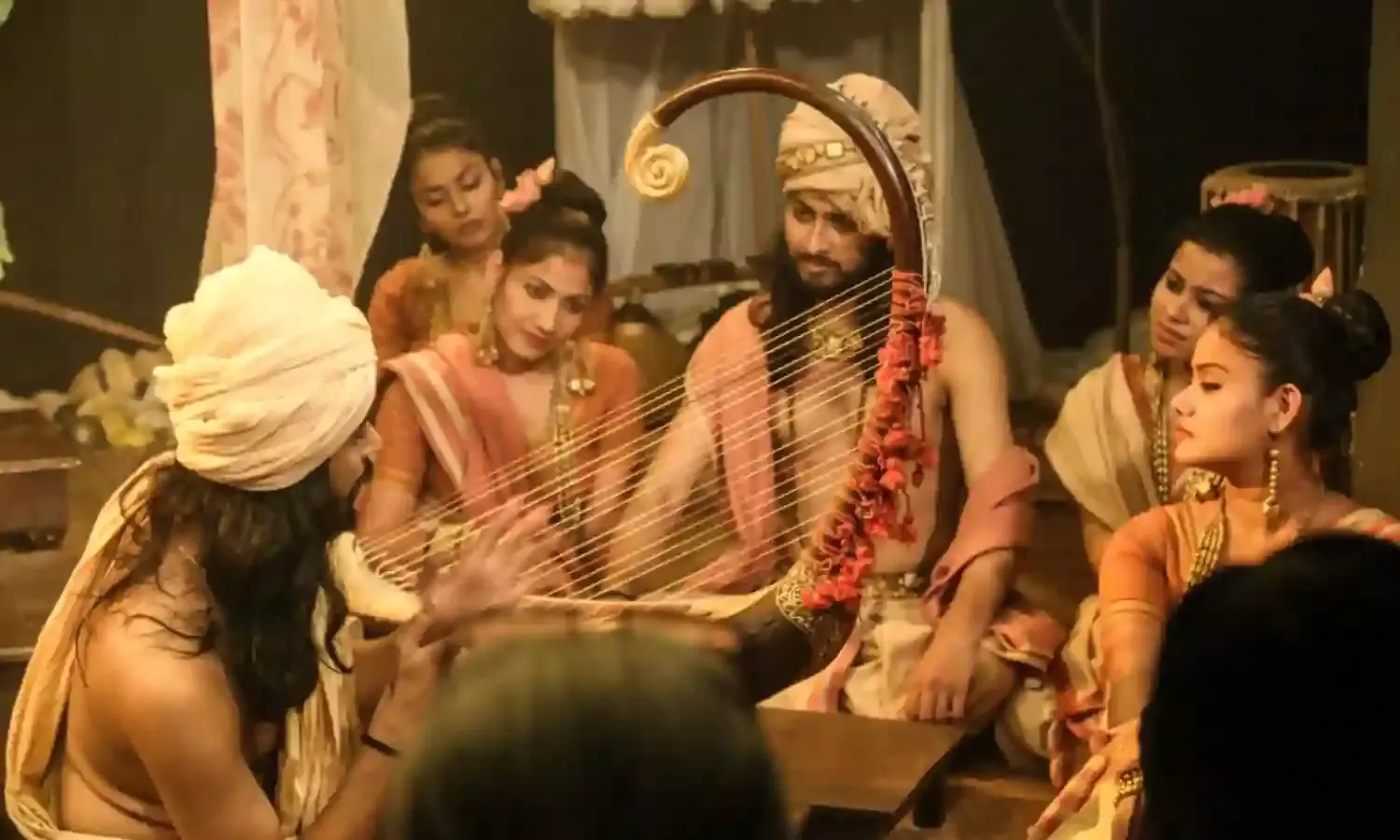The Lotus Consent: A Classical Sanskrit Play
The entire performance is enriched by grace, beauty and artistry

It is extremely challenging even to watch a play performed in a genre you have never witnessed before, in a language – Sanskrit – you are not familiar with, with a form that is unique and content drawn majorly from the theory of classical Sanskrit drama. Leave alone writing about the play and its performance, the technical intricacies, and the story it narrates over the two hours of performance.
Piyal Bhattacharya is responsible for training the actors, directing the sets and prop designs along with Moumita Sankhari, and presenting the play in its finished form, of Marga Natya. He has studied everything there is to know to define this form, which he says is ‘practised as a guru-shishya parampara system of training under the Drama Section of the Sangeet Natak Akademi’.
The Lotus Consent is explained in great detail in the programme catalogue which spells out the characters and their significance within the performance, and the story according to the rigid rules of Bharata’s Natya Shastra through the seven functions as follows: Angik which refers to expression through the body, Vachik meaning elocution and speech or dialogue, Sattvik or the spiritual element, Geet standing for lyrics and song, Vadya, signifying musical instruments, Aharya, the function of eating, and Sajja meaning relaxation.
Bhattacharya has taken these basic principles to create the practice of Marga Natya through performance theatre.
The Lotus Consent presents what may be rightly described as a one-man performance, where the same actor performs different roles, even at the same time, with his dialogue or monologue in Sanskrit, with a little Hindi thrown in.
He performs as the Nandi to open the play with an invocation of Lord Shiva. Once that is over, he turns into the Sutradhar (the one who holds the thread of the play from beginning to end) who is a common character in all Sanskrit plays, and then evolves into Beeta, another constant character in classical Sanskrit drama who, however, has a distinct name – Samvatsara.
As Beeta he is a microcosm of the middle class, becoming a messenger carrying the message of love as and when necessary, and narrates the backdrop and a brief synopsis of the play.
The “Lotus” in the title stands for a real lotus, handed over to Beeta to carry to Devasena as a token of the love of Muladeva, King of Pataliputra, who has fallen in love with Devasena, his wife’s sister who lives in Ujjain. Muladeva is a happily married man, yet he is desperate to unite with Devasena. The play negotiates the journey and the adventures Beeta must traverse in order to reach Devasena, and get her consent through the Lotus.
So, we are introduced to different characters with expertise in different fields but with human follies of their own.
Duttakalashi, a scholar of pre-Paninian Sanskrit, is rigid about the grammar of his language but is also in an adulterous relationship with a prostitute. Duttakalashi does not accept the concept that language is and must remain fluid, flexible and ever-changing.
Then there is an older Beeta named Mridangavasulaka, who no longer performs professionally, but is able to impress the younger Beeta as he performs slices of his earlier roles in front of the younger Beeta.
A Buddhist member of a Sangha cohabits with a prostitute in disguise and there are similar incidents filling the play.
There is a mixed chorus coming in from the backdrop to offer rhythm and music and some sensuous colour to Beeta’s journey, as they listen to him playing all the different roles himself.
And so the journey continues, unfolding the peels from the larger illusion of moral hypocrisy of the learned and the pious, from the different schools they live within. But the end has a rather unusual twist, not expected from a classical play as old as this one.
Sayak Mitra who plays Beeta and the other main roles fascinates us with his multiple role-playing, which clarifies instead of confusing. The costumes are so artistically designed, in soft pastels and with different degrees of transparency, that in a single frame I captured a still image appears like a beautiful ancient painting come alive before your eyes.
The props, especially the mosquito-net like circular curtain, lend themselves to multiple uses with conviction and artistry. The music, with a combination of string and percussion instruments along with a harmonium and even a reconstructed ancient harp, provide just the right aesthetic backdrop to a very unusual performance.
The entire performance is enriched by grace, beauty, artistry and the effort it demands from the actors in memorising dialogue in Sanskrit.
The aim of the troupe Chidakash Kalalay, founded in 2013, is to build consciousness about the richness and importance of the guru-shishya parampara (mentor-disciple tradition) and to engender self-improvement on the part of the disciples who commit themselves to the movement.
In its present form and language, the play will attract only a niche audience, and therefore it may need to educate the audience with a brief introduction to this genre of drama before the performance actually begins.
Two points one would like to make are (a) this kind of play needs a wider and larger proscenium to permit more space and mobility to the actors, and (b) the length of the play, initially at least, needs to be shorter.
Take a bow Chidakash Kalalay and its founder Piyal Bhattacharya.
Play: The Lotus Consent
Group: Chidakash Kalalaya
Artistic Director: Piyal Bhattacharya
Performance: Padatik Little Theatre, May 2019



